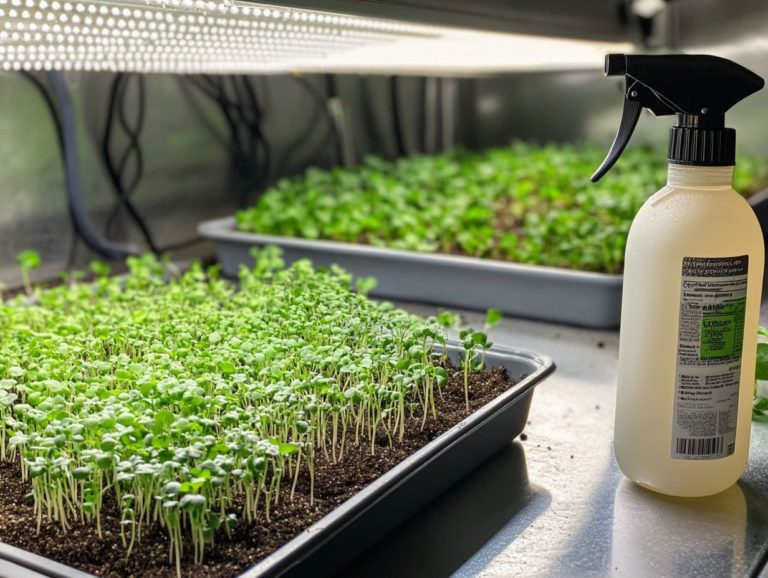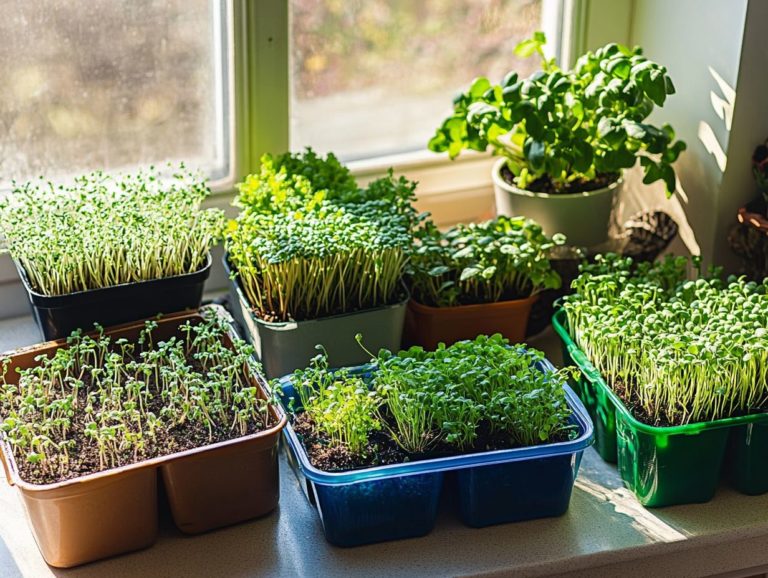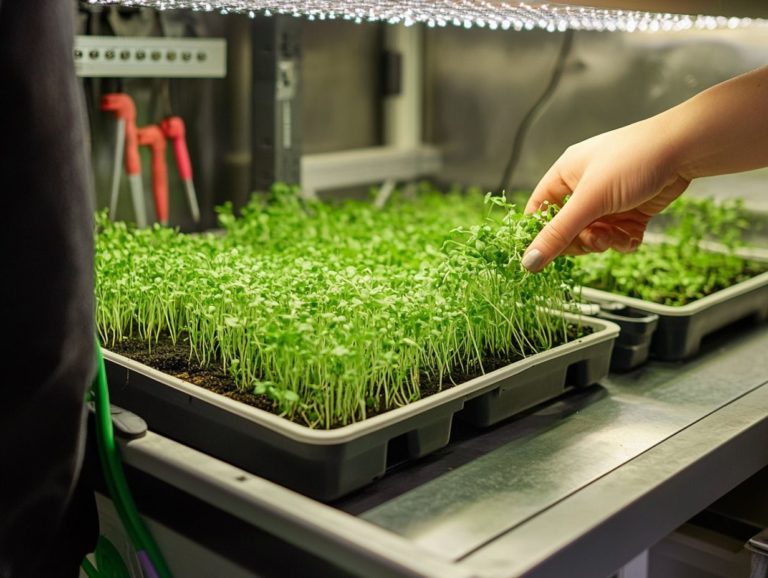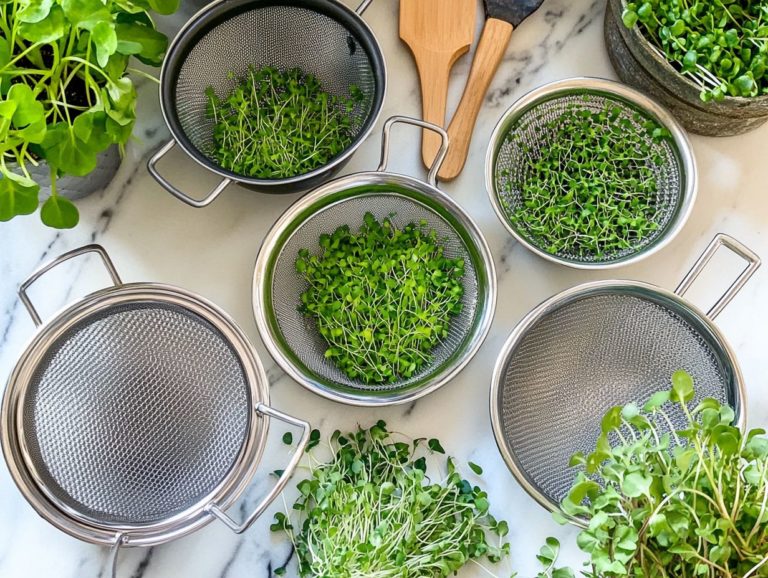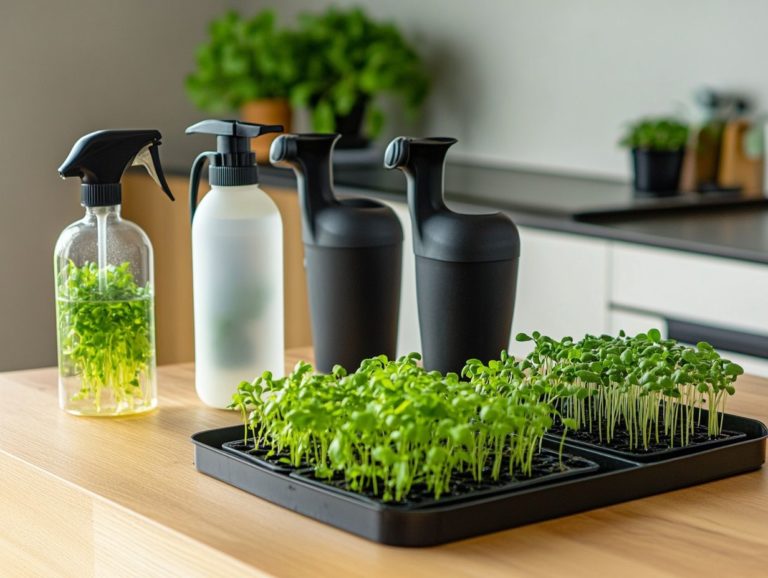5 Best Compost for Microgreen Growth
When you re nurturing vibrant microgreens, the quality of your compost truly makes all the difference.
Here are five of the best types of compost ranging from kitchen scraps to manure each bringing unique benefits for your tiny green plants. Discover the essential nutrients that compost provides, how it boosts soil quality, and the steps to create your own blend right at home.
Ready to elevate your microgreen garden? Don t wait! Dive in now and discover how compost can transform your microgreen garden!
Contents
- Key Takeaways:
- 1. Compost Made from Kitchen Scraps
- 2. Vermicompost
- 3. Mushroom Compost
- 4. Compost Made from Yard Waste
- 5. Compost Made from Manure
- What Is Compost and Why Is It Important for Microgreen Growth?
- Frequently Asked Questions
- What are the best compost choices for growing microgreens?
- What is worm castings compost and why is it ideal for microgreens?
- Why is mushroom compost a great choice for growing microgreens?
- How does seaweed compost benefit microgreen growth?
- What makes chicken manure compost suitable for microgreen growth?
- What is Vermicompost and How Does It Help Microgreen Growth?
Key Takeaways:
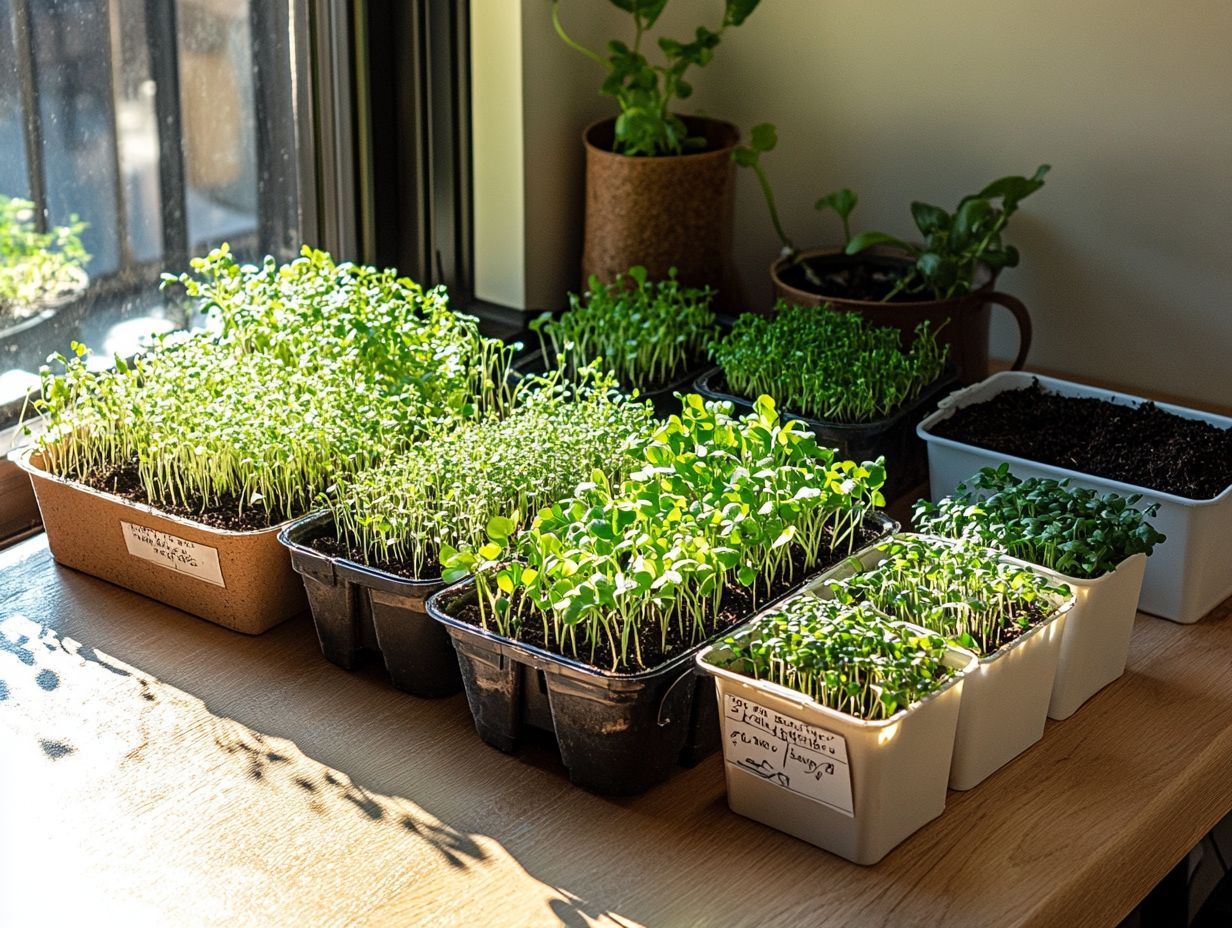
- Compost made from kitchen scraps is an affordable and easily accessible option for microgreen growth, providing essential nutrients like nitrogen, phosphorus, and potassium.
- Vermicompost, also known as worm castings, is a nutrient-rich organic option that promotes healthy growth and enhances soil quality for microgreens.
- Mushroom compost is a popular choice for microgreen growth due to its high nutrient content, ability to retain moisture, and capacity to suppress harmful pathogens.
1. Compost Made from Kitchen Scraps
Composting kitchen scraps is a sustainable and nutrient-rich choice for boosting your microgreen growth. By utilizing organic waste that would typically end up in a landfill, you recycle food scraps and enrich your soil with essential nutrients. This boosts healthy seed germination!
To efficiently collect kitchen scraps, consider setting up a dedicated compost bin in your kitchen. This bin can hold peels from fruits and vegetables, coffee grounds, eggshells, and other organic refuse. Ideal materials for your compost include leafy greens like lettuce and kale, as well as fruit scraps such as apple cores and banana peels.
These additions contribute vital organic nutrients to the compost and enhance moisture retention in the soil, creating an ideal environment for microgreens.
A well-balanced compost fosters the growth of beneficial bacteria, cultivating an ecosystem that effectively breaks down nutrients. This ultimately translates to healthier and more vibrant microgreens for your garden.
2. Vermicompost
Vermicompost, which is rich in beneficial bacteria and worm castings, is an exceptional soil amendment for growing microgreens. It enhances their nutrient uptake and overall vitality.
This remarkable organic material is created through a careful process that composts organic waste with the help of specific worms like red wigglers and European nightcrawlers. These little creatures efficiently break down food scraps and yard waste. By providing a balanced environment for these worms, you can harness nature s power to produce a rich, dark, crumbly substance teeming with nutrients.
Incorporating vermicompost into your soil improves its structure and water retention while fostering beneficial microbial activity. This results in healthier plants and promotes faster growth rates in microgreens, significantly boosting crop yields. For those looking for innovative methods, exploring 5 creative ways to grow microgreens can be especially beneficial. Vermicompost is a preferred choice for both gardeners and commercial producers alike.
3. Mushroom Compost
Mushroom compost is a nutrient-rich soil media made from the farming of edible mushrooms, making it a perfect amendment for your organic farming endeavors and microgreen kits.
This compost features a well-balanced profile of essential nutrients nitrogen, phosphorus, and potassium that are crucial for healthy plant growth. Its abundant organic matter enhances soil structure and boosts water retention, creating an ideal environment for your seedlings.
If you’re considering soilless media options, mushroom compost is an excellent choice, providing optimal aeration and drainage. Its capacity to support beneficial microorganisms fosters a thriving ecosystem that promotes robust microgreen production. For more tips on selecting the best options, check out this guide on how to choose the right soil for microgreen growth, making it invaluable for any home gardener looking to elevate their gardening experience.
4. Compost Made from Yard Waste
Composting your yard waste champions sustainable gardening practices and produces exceptional soil that boosts moisture retention and nutrient availability for your microgreens.
By incorporating plant clippings, fallen leaves, and small branches, you create compost rich in organic material. This forms a rich soil for beneficial microorganisms.
These tiny powerhouses break down the organic matter, enriching your soil with essential elements like nitrogen and phosphorus. Adding this compost to your planting beds significantly enhances soil structure, aeration, and water-holding capacity.
Start composting today to see your microgreens thrive tomorrow! This natural method elevates the vibrant growth of your microgreens.
5. Compost Made from Manure

Compost derived from manure is a powerful natural fertilizer that boosts microbial growth while providing a balanced nutrient profile essential for optimal microgreen cultivation.
You ll find various manure types, including chicken, cow, and horse, each offering unique advantages. Chicken manure, abundant in nitrogen, accelerates decomposition and enhances nutrient density making it an excellent choice.
Cow manure excels at moisture retention and improving soil structure, ensuring your plants have the best environment to thrive. While horse manure has lower nitrogen content, it enriches the compost with valuable organic matter, promoting microbial activity.
When these manures are composted correctly, they create a rich substrate that nourishes your plants and supports root penetration and seed germination. Healthy roots lead to stronger, more vibrant growth, ultimately resulting in a bountiful harvest.
What Is Compost and Why Is It Important for Microgreen Growth?
Compost is a treasure trove of nutrient-rich organic matter that dramatically enhances soil quality, making it essential for growing microgreens. It boosts seed germination rates and delivers vital organic nutrients that your plants crave.
This organic marvel typically consists of decomposed plant matter, kitchen scraps, and yard waste. This creates a rich tapestry of macronutrients like nitrogen, phosphorus, and potassium, along with beneficial microorganisms that work wonders in the soil.
Incorporating compost into your garden soil improves its structure and enhances aeration, water retention, and drainage elements crucial for vibrant plant growth.
By embracing this natural amendment in your sustainable gardening practices, you reduce your reliance on chemical fertilizers while fostering a healthy ecosystem. Using compost to cultivate microgreens ensures robust growth, higher yields, and greater resilience against pests, contributing to a flourishing, sustainable garden environment.
What Are the Key Nutrients in Compost for Microgreens?
Key nutrients in compost such as nitrogen, phosphorus, and potassium are essential for your microgreens’ healthy growth. They facilitate optimal nutrient uptake and enhance overall plant vitality.
Along with these primary nutrients, trace elements like calcium, magnesium, and sulfur play crucial roles in various physiological processes. They support cellular structure and enzyme function. The balanced combination of these nutrients ensures your microgreens develop robust root systems and lush foliage.
Using compost as a natural soil amendment enriches your growing medium by boosting microbial activity and improving soil structure. This aids in nutrient retention and promotes better aeration and drainage, creating the ideal environment for your microgreens to thrive.
Ultimately, incorporating compost leads to healthier and more nutrient-dense microgreens, showcasing the transformative impact of nutrient-rich soil on your gardening success.
How Does Compost Improve Soil Quality for Microgreens?
Compost significantly enhances soil quality for your microgreens by improving moisture retention, promoting beneficial bacteria, and creating a balanced environment that’s perfect for healthy plant growth.
This organic matter is essential for improving soil structure. It transforms compacted soil into a crumbly, airy texture that allows for better root expansion and nutrient absorption. With compost in the mix, you ll achieve better aeration, ensuring your soil stays well-drained while still retaining enough moisture for optimal germination.
These enhanced soil characteristics not only support robust plant development but also create a thriving microclimate, a small area with different atmospheric conditions. This reduces the risk of disease and encourages quicker harvest cycles, making compost an ideal choice for anyone passionate about growing microgreens. To ensure optimal growth, it’s important to consider the 5 essential nutrients for microgreen growth.
What Are the Different Types of Compost and Their Benefits?
You have a variety of compost options at your disposal, each offering distinct benefits for microgreens, such as kitchen scrap compost, vermicompost, and mushroom compost. These not only enhance your organic farming practices but also elevate your gardening game. Incorporate coconut coir as a soil media to benefit your growing microgreens.
Each type of compost brings unique advantages to soil conditioning and nutrient profiles. Kitchen scrap compost, for instance, is rich in nitrogen and boosts the microbial community, creating a fertile haven for your young plants. To enhance your growing efforts, consider the 5 key factors for successful microgreen growing. Meanwhile, vermicompost, compost created by worms, is rich in nutrients and promotes vibrant growth while bolstering disease resistance.
On another note, mushroom compost an ingenious byproduct of mushroom farming boasts impressive water retention capabilities, ensuring your microgreens receive just the right amount of moisture without the risk of waterlogging.
Incorporate these composts into your gardening routine to enrich your soil and embrace sustainable growing methods. This makes them perfect for urban gardens and home growers who are eager to cultivate nutrient-dense greens.
How Can One Make Their Own Compost for Microgreens?
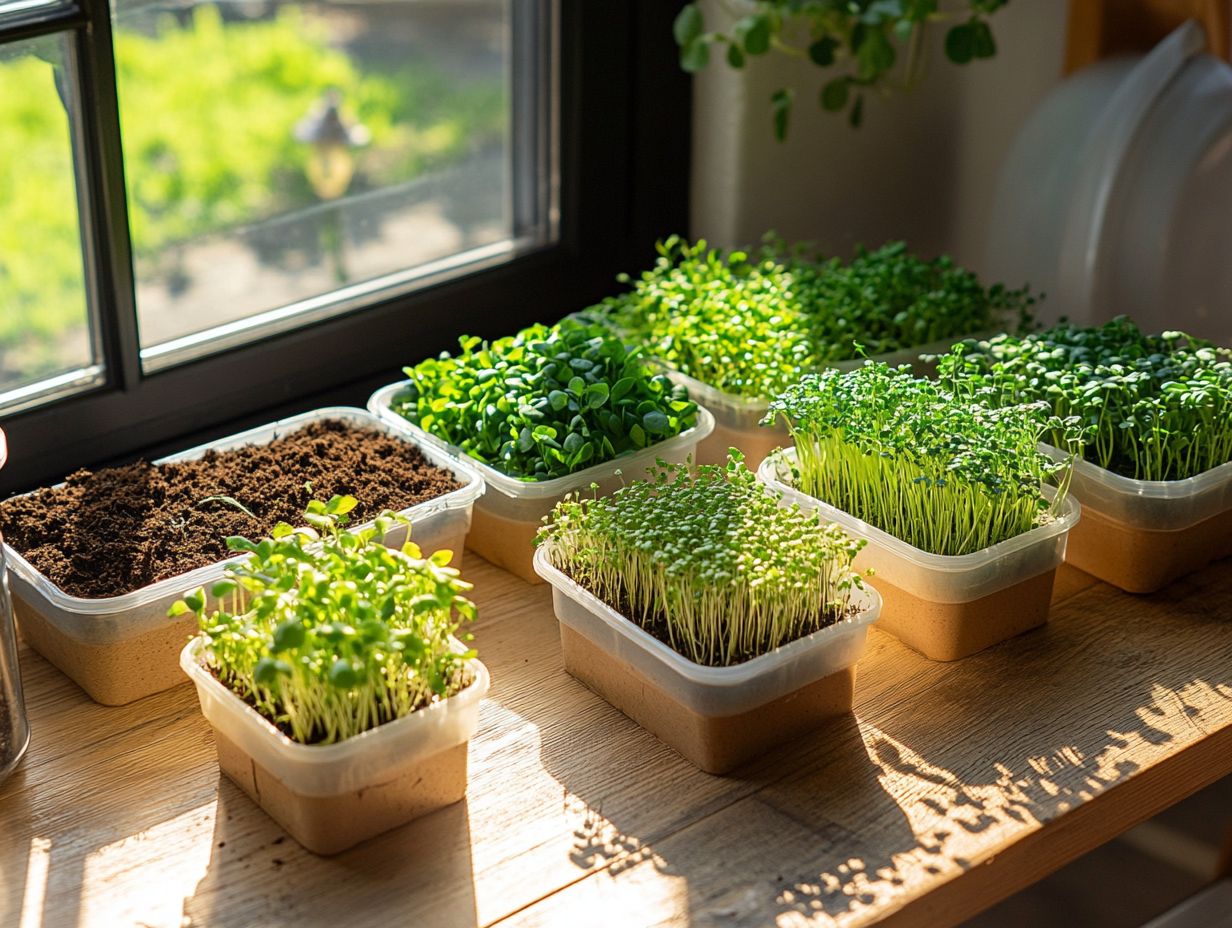
Making your own compost for microgreens is exciting and rewarding! It s a step toward sustainable gardening that ensures you re using organic nutrients perfectly suited to your specific growing conditions, including seed germination.
By transforming kitchen scraps and yard waste into nutrient-rich soil, you can reduce waste while simultaneously enhancing the overall health of your microgreens. This step-by-step guide will walk you through gathering essential materials, such as a diverse array of green nitrogen sources like vegetable scraps and coffee grounds, complemented by brown carbon sources like dried leaves and cardboard. Additionally, consider following 5 tips for successful microgreen germination to maximize your results.
Understanding the composting process is key. Layering these materials in a compost bin will promote decomposition, while regularly turning the compost will aerate it and expedite the breakdown process. When the compost is ready, it will enrich your soil, providing vital nutrients that dramatically enhance the growth and flavor of your microgreens. To maximize your harvest, consider using the best containers for microgreen cultivation, ultimately leading to a more abundant harvest.
What Are the Factors to Consider When Choosing the Best Compost for Microgreens?
When selecting the ideal compost for your microgreens, it’s essential to consider several factors, including nutrient balance, compost quality, and how well it suits your specific growing conditions. These factors are vital for a thriving microgreens harvest!
Moreover, pH levels are important because microgreens flourish in a slightly acidic to neutral environment. Moisture retention is also key; your compost should avoid both waterlogging and drought stress, allowing your seedlings to receive just the right amount of hydration. To ensure success, be cautious of the top 5 mistakes in growing microgreens.
Microbial activity within the compost is crucial for nutrient breakdown, encouraging healthier growth and enhancing your yield. Altogether, these factors affect the immediate health of your microgreens and influence their resilience against diseases, impacting both the quality and quantity of your harvest.
Frequently Asked Questions
What are the best compost choices for growing microgreens?
The top 5 compost options for optimal microgreen growth are worm castings, mushroom compost, seaweed compost, chicken manure compost, and vermicompost. Consider earthworm castings as a notable choice for enhancing soil amendments.
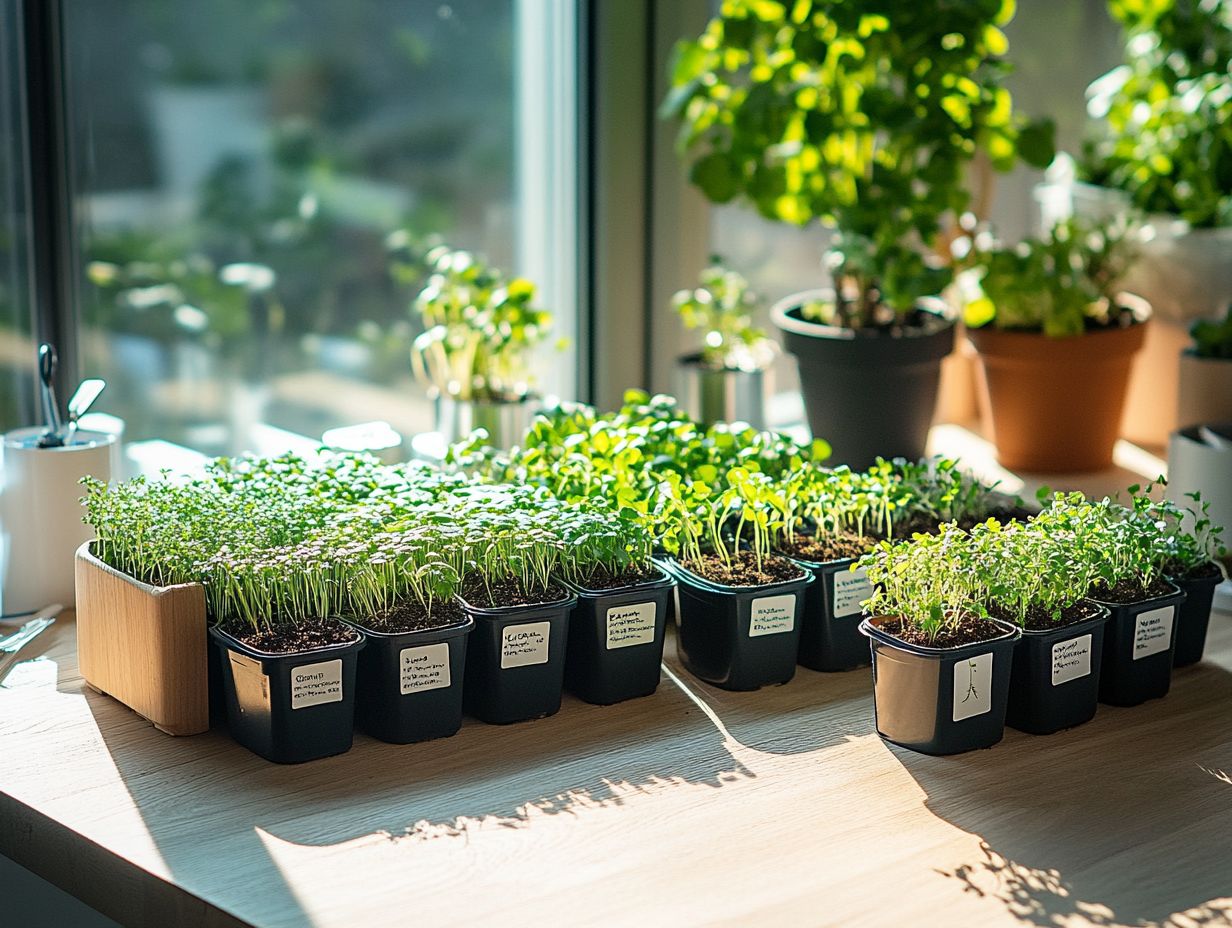
What is worm castings compost and why is it ideal for microgreens?
Worm castings compost is made by allowing worms to break down organic matter. This results in a nutrient-rich, fine-textured soil amendment. It is ideal for microgreens because it has balanced nutrients and a neutral pH level. It works great with soilless blends.
Why is mushroom compost a great choice for growing microgreens?
Mushroom compost is a blend of organic materials used to grow mushrooms, such as straw, horse manure, and poultry litter. It is rich in nutrients and improves soil structure. Often, it is combined with peat moss for optimal results.
How does seaweed compost benefit microgreen growth?
Seaweed compost is derived from dried and decomposed seaweed, making it rich in minerals and micronutrients. It promotes strong root development and provides essential nutrients for healthy growth, making it a valuable nutrient mix for your microgreens business.
What makes chicken manure compost suitable for microgreen growth?
Chicken manure compost combines chicken manure with other organic materials. It is high in nitrogen, essential for leafy green growth, and improves soil structure and moisture retention. This is especially important during the blackout period when light exposure is limited.
What is Vermicompost and How Does It Help Microgreen Growth?
Vermicompost is made by composting worms that break down organic matter. This process creates a nutrient-rich soil amendment.
It helps microgreens thrive by providing essential nutrients and improving soil texture. Vermicompost also encourages beneficial microbes that support plant health.
You can find vermicompost at various hydroponic supply stores. It’s a fantastic choice for anyone looking to boost their microgreen garden!

